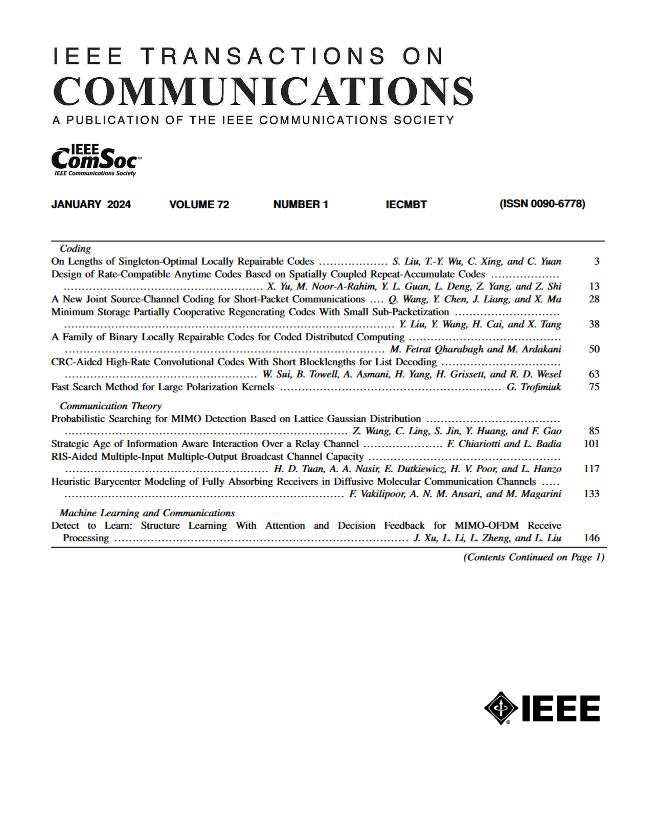抖动下的UAV-MIMO:集中式与分布式实现的比较分析
IF 8.3
2区 计算机科学
Q1 ENGINEERING, ELECTRICAL & ELECTRONIC
引用次数: 0
摘要
本文研究了随机摆动对无人机通信性能的影响。我们考虑了无人机多输入多输出(MIMO)系统的两种实际实现形式,即1)集中式实现,其中紧凑的多天线阵列部署在单个无人机平台上,因此摆动直接影响整个阵列;2)分布式实现,由协同无人机群组成虚拟MIMO系统,每个发射天线独立发生抖振。在这两种情况下,我们定义并分析了波束形成增益损失因子作为性能指标,以评估抖动引起的不利影响。基于导出的解析表达式,在考虑载波频率、抖动方差、用户位置、天线数、天线间距等不同系统和实现参数的情况下,对集中式和分布式实现方式进行了比较,分别展示了其较优的运行场景。研究结果表明,分布式MIMO具有较强的抗干扰能力,特别是在天线数量较大的情况下。仿真结果验证了推导出的解析表达式的准确性,并证实了相应的结论。本文章由计算机程序翻译,如有差异,请以英文原文为准。
UAV-MIMO Under Wobbling: A Comparative Analysis of Centralized and Distributed Implementations
In this paper, we investigate the impact of random wobbling on the performance of unmanned aerial vehicle (UAV) communications. We consider two practical implementation forms of UAV-multiple input multiple output (MIMO) system, namely 1) centralized implementation, where a compact multi-antenna array is deployed on a single UAV platform and hence wobbling directly has impact on the entire array; 2) distributed implementation, where a virtual MIMO system is formed via cooperative UAV swarm, and wobbling occurs independently for every single transmit antenna. For both cases, we define and analyze the beamforming gain loss-factor as the performance metric to evaluate the adverse effect caused by wobbling. Based on derived analytical expressions, the centralized and distributed implementations are compared to show their preferable operating scenarios, respectively, considering different system and implementation parameters including the carrier frequency, wobbling variance, user position, antenna number, and inter-antenna spacing, etc. It is revealed that the distributed MIMO implementation could be more robust to wobbling, especially when the number of antennas is large. Simulations verify the accuracy of derived analytical expressions, and confirm the corresponding conclusions.
求助全文
通过发布文献求助,成功后即可免费获取论文全文。
去求助
来源期刊

IEEE Transactions on Communications
工程技术-电信学
CiteScore
16.10
自引率
8.40%
发文量
528
审稿时长
4.1 months
期刊介绍:
The IEEE Transactions on Communications is dedicated to publishing high-quality manuscripts that showcase advancements in the state-of-the-art of telecommunications. Our scope encompasses all aspects of telecommunications, including telephone, telegraphy, facsimile, and television, facilitated by electromagnetic propagation methods such as radio, wire, aerial, underground, coaxial, and submarine cables, as well as waveguides, communication satellites, and lasers. We cover telecommunications in various settings, including marine, aeronautical, space, and fixed station services, addressing topics such as repeaters, radio relaying, signal storage, regeneration, error detection and correction, multiplexing, carrier techniques, communication switching systems, data communications, and communication theory. Join us in advancing the field of telecommunications through groundbreaking research and innovation.
 求助内容:
求助内容: 应助结果提醒方式:
应助结果提醒方式:


